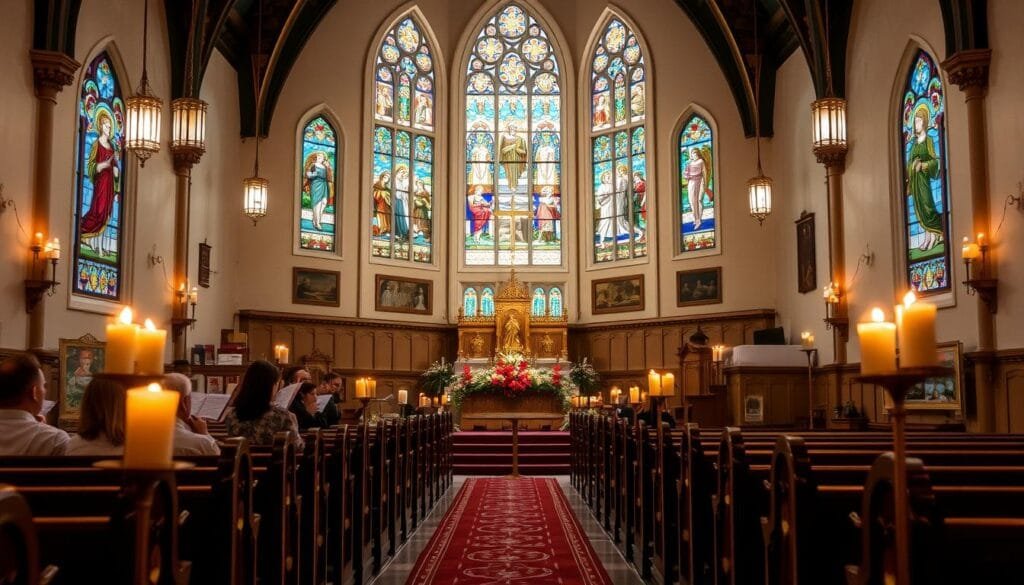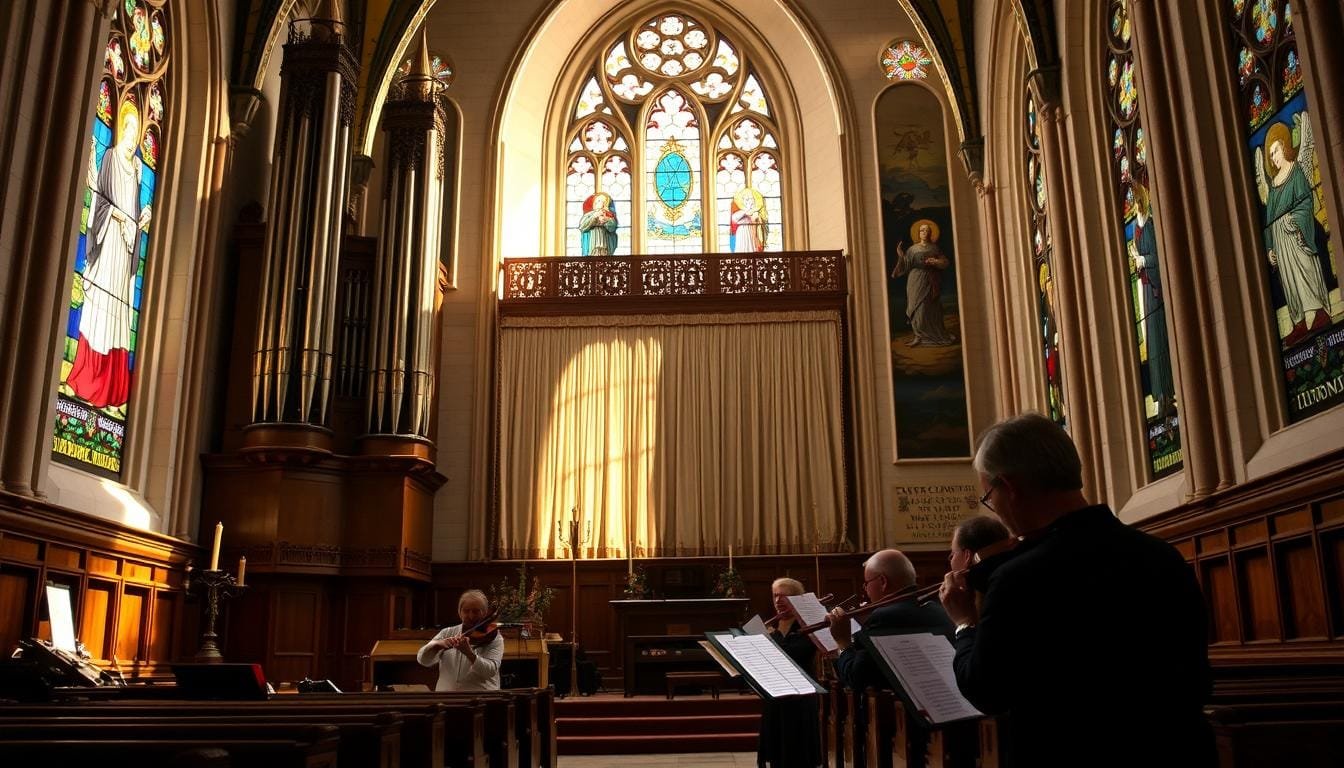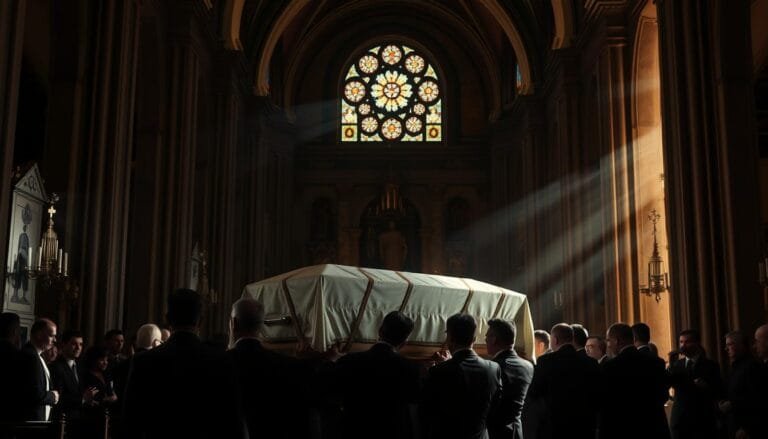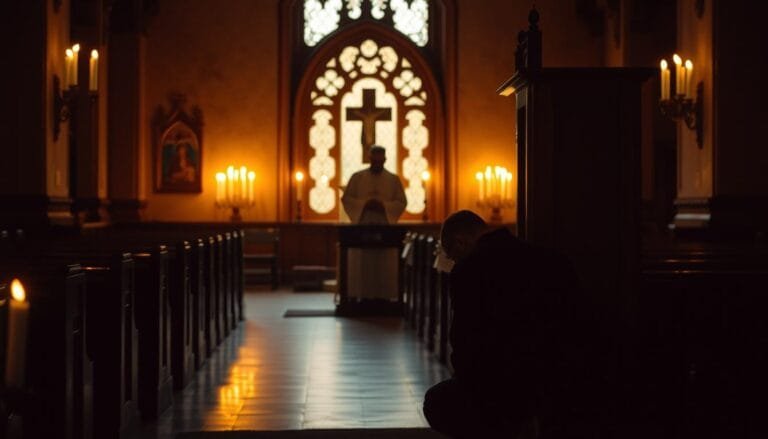Sacred Music in Catholic Prayer and Worship
This website contains affiliate links. As an Amazon Associate, I earn from qualifying purchases. The content on this website was created with the help of AI.
Did you know over 400 students joined online and in-person workshops at the Catholic Institute of Sacred Music in San Francisco in the first year?
This shows how much interest there is in Catholic sacred music. It’s a key part of worship music, making our spiritual experiences richer and bringing us together in worship.
Sacred music lifts our spirits and draws us closer to our faith. In this article, we’ll look at sacred music’s definition, history, and types like Gregorian chant and polyphony.
We’ll also see why it’s crucial in the Catholic Church and how it makes worship more meaningful and contemplative.
Key Takeaways
- Sacred music is vital in Catholic prayer and worship, making our spiritual experiences richer and uniting us in worship music.
- Catholic sacred music has a rich history and tradition, with forms like Gregorian chant and polyphony being key in worship.
- The Catholic Church has clear criteria for sacred music, including holiness, artistic soundness, and universality.
- Sacred music should be different from secular music and focus on universal themes to be effective in worship.
- Gregorian chant is a traditional and revered form of sacred music, seen as the supreme model and normative music for the Roman Rite.
- The pipe organ is deeply connected with the church and is often used in churches to create a contemplative atmosphere.
Understanding Catholic Sacred Music: Our Musical Foundation
We explore the world of Catholic sacred music, looking at its role in our faith. To grasp this, we need to understand the rules set by Pope Pius X.
These rules focus on sanctity, goodness of form, and universality. They help us see the value of sacred music, like Gregorian chant and polyphony, which have shaped our liturgical music for ages.
The history of sacred music in the Catholic Church is both rich and complex. Chant was key in the early Church.
Later, chants evolved, and instrumental music was initially seen as taboo due to its links to other cultures.
Harmony was slow to arrive, and it wasn’t until the Late Middle Ages that it became common. The Edict of Constantine marked a turning point, making chants more melismatic.
Defining Sacred Music in Catholic Tradition
In our tradition, sacred music is more than art; it’s a way to worship and pray. The Catholic Sacred Music Project works to revive sacred music in communities.
It’s backed by leaders like Robert Cardinal Sarah and Bishop David O’Connell, who see its value in our faith.
The Three Judgments of Sacred Music
Pope Pius X outlined three key judgments for sacred music: sanctity, goodness of form, and universality.
These standards help us judge if music is right for worship. The timeless beauty of Gregorian chant and Catholic hymns shows their power to deepen our faith and bond with God.
The Historical Journey of Catholic Sacred Music
Exploring the history of Catholic sacred music reveals many changes over time. In the early Church, chant was preferred because it was seen as different from secular music.
This led to the creation of Gregorian Chant, named after Pope Gregory I, which became key in Catholic music.
The High Middle Ages saw harmony enter Church music, changing worship music forever.
The Renaissance brought more changes, like polyphony, which made text hard to understand.
Composers like Heinrich Isaac and Orlando De Lassus used secular melodies for sacred songs, causing debate in the Church.
Now, Catholic sacred music is more diverse than ever. Traditional choirs and modern Christian artists add to the rich worship music landscape.
The Second Vatican Council allowed for Mass in vernacular languages, broadening sacred music’s scope. Looking back, we see how each era has shaped Catholic sacred music, leaving its mark.
Catholic sacred music has been a vital part of worship for centuries. Its evolution mirrors the Church’s growth and adaptation to new times.
As we look to the future, it’s crucial to keep our musical heritage alive while welcoming new forms of worship music that speak to today’s listeners.
Gregorian Chant: The Heart of Catholic Musical Tradition
Gregorian chant is at the heart of Catholic worship. It has been a key part of Catholic liturgy for centuries. This sacred music brings unity and timelessness to the faithful.
Gregorian chant stands out due to its unique features. It uses eight different modes and has ametrical rhythm. This makes it different from other music.
Exploring the Gregorian chant’s history shows its importance in Catholic worship. Gregorian chant is seen as the top model for sacred music, fitting well with the Roman liturgy.
Its development shows the lasting impact of sacred music in the Catholic tradition.
From the early Christian Church to the Middle Ages, Gregorian chant has shaped the Catholic Church’s musical heritage.
Origins and Development of Gregorian Chant
The history of Gregorian chant is rich and complex. It spans centuries, influenced by various traditions. The core of its repertoire was formed before 800, with most completed by 1200.
This period also saw the development of the eight modes in Gregorian chant. These modes roughly match the Western and Eastern halves of the ancient Roman Empire.
Understanding Chant Notation
Gregorian chant notation is unique and complex. It requires a deep understanding of the music and its context. The use of neumes, or symbols, to show pitch and rhythm is a key feature.
This notation allows for a nuanced and expressive performance. It’s essential for the chant’s spiritual significance.
Gregorian chant has also shaped the tradition of catholic hymns. Its use in worship has inspired many hymns and sacred songs. These continue to be important in Catholic liturgy today.
Reflecting on Gregorian chant’s role in Catholic worship reminds us of sacred music’s power. It inspires and uplifts us.
Traditional Catholic Hymns and Their Significance
We understand the value of traditional catholic hymns in showing faith and devotion.
These hymns have been around for centuries, making worship music better and bringing people together.
Sadly, many Catholics miss out on sacred music in their churches, showing a big need for traditional hymns in worship.
Looking at hymnals like the Westminster Hymnal and the Collegeville Hymnal, we find a treasure of traditional catholic hymns.
These hymns can make worship music richer. For instance, the top ten Catholic hymns are classics that still move and uplift people. Some famous ones are:
- Pange Lingua
- Ave Maria
- Adoro Te Devote

In summary, traditional Catholic hymns are key in worship music. We should not forget their importance.
By using these hymns in our services, we can make worship more meaningful and engaging for everyone.
| Hymnal | Year Published | Number of Pages |
|---|---|---|
| Westminster Hymnal | 1952 | 452 |
| Collegeville Hymnal | 1990 | 700 |
| Worship IV Hymnal | 2011 | 1,400 |
Sacred Music in the Modern Catholic Mass
We believe that Catholic sacred music is key in the modern Catholic Mass. It has the power to uplift and inspire us.
The liturgy is a big part of our worship. The music should be holy, beautiful, and universal.
When it comes to worship music, we aim for excellence and authenticity. We can do this by using traditional sacred music, like Gregorian chant, in our Masses.
We should also choose instruments that fit well with sacred music, avoiding those used in secular music.
- Sanctity and goodness of form
- Avoiding profanity and secular influences
- The prominence of Gregorian chant
- Introduction of new forms and innovations with caution
By following these guidelines, we can make our worship more meaningful and uplifting. This way, we create a better experience for everyone.
| Music Type | Description |
|---|---|
| Gregorian Chant | A traditional and sacred form of music |
| Traditional Hymns | Timeless and uplifting worship music |
| Contemporary Music | Modern music that is holy, beautiful, and universal |
Preserving Our Musical Heritage in Contemporary Worship
We know how crucial it is to keep our Catholic musical heritage alive in today’s worship.
It’s about finding a balance between old and new, making sure our Church’s history is kept for those who come after us.
The Gregorian chant plays a key role in this, and its importance should not be forgotten.
Lately, there’s been a growing interest in catholic hymns and traditional sacred music. This is shown in the work of places like the Pontifical Institute of Sacred Music in Rome.
They offer courses in music composition, choir leading, organ playing, and chant. These programs help train musicians and teachers around the world, keeping our musical heritage alive.
Some great examples of keeping our musical heritage alive include:
- The ensemble Floriani performs a Gregorian chant and other traditional sacred music in Catholic worship.
- The Catholic Sacred Music Project at Princeton University helps bring back traditional music in the Church.
By keeping our musical heritage alive, we make sure that the beautiful tradition of Catholic hymns and Gregorian chant will continue to inspire and uplift future generations.

We need to find a balance, mixing traditional music with modern worship. And also, embracing new ways to express our faith.
| Organization | Mission |
|---|---|
| Pontifical Institute of Sacred Music | To promote the preservation and development of sacred music in the Catholic Church |
| Catholic Sacred Music Project | To revive and promote traditional sacred music within the Church |
The Transformative Power of Sacred Music in Prayer
Worship music has a deep impact on our spiritual lives. It’s key to look at how catholic sacred music changes our prayer. This music lifts our spirits and brings us together in worship.
Peter Carter says sacred music prepares our hearts for Christ in the liturgy. It also touches those outside the Church and in our culture.
The Catholic Sacred Music Project, started in 2021, works to spread holiness through sacred music. It offers summer programs at Princeton University to deepen our love for catholic sacred music.
Notable figures like Conner David McCain and Chase Fowler have been part of the Conducting Institute.
They teach at St. Joseph’s Seminary in New York and Mater Dei parish in Dallas. Their stories show how worship music shapes our spiritual paths and brings us together.
The Psalms for All Seasons project, led by Dr. Matthew J C Ward, is another example. It creates new melodies for the liturgical calendar.
This aims to bring unity and deepen our prayer in the Mass. The CTS Music YouTube channel has recordings, including Psalms for all Seasons, to help deepen our spiritual journey.
By embracing catholic sacred music in our worship, we can have a more meaningful spiritual experience.
Exploring sacred music in prayer can help us find unity, devotion, and a closer faith connection.
| Project | Objective | Outcome |
|---|---|---|
| Catholic Sacred Music Project | Promote holiness through sacred music | Foster a deeper understanding and appreciation of catholic sacred music |
| Psalms for All Seasons | Reimagine responsorial psalms | Foster unity, familiarity, and prayerful participation in the Mass |
Conclusion: Embracing Our Rich Musical Legacy in Faith
As we wrap up our look at Catholic sacred music, it’s clear that the Church’s musical legacy is very important.
It includes the timeless beauty of Gregorian chant and the inspiring hymns that have fed believers for generations. This musical tradition is a sacred gift we must cherish and keep alive.
Sacred music has the power to change our hearts and bring us closer to God.
Reverend John Davidson says, “Hymns help us talk to God, sharing deep truths in a way that’s easy to understand.”
Hymns like “A Mighty Fortress Is Our God” by Martin Luther, “Day By Day” by Lina Sandell, and “Come Thou Fount Of Every Blessing” by Robert Robinson can feed our faith and strengthen our connection with the divine.
Let’s remember St. Thomas Aquinas’ wise words as we embrace this musical legacy.
He said we should respect the customs and traditions passed down to us, as they are like God’s laws.
By honoring and engaging with the sacred music of our Catholic heritage, we not only enrich our own spiritual lives.
We also make sure this precious gift is shared with future generations, who will be nourished and inspired by its beauty and power.
















